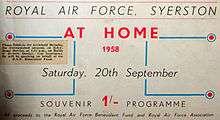1958 Syerston Avro Vulcan crash
|
VX770 in flight | |
| Accident summary | |
|---|---|
| Date | 20 September 1958 |
| Summary | Structural failure |
| Site |
RAF Syerston, Nottinghamshire 53°1′22.49″N 0°54′45.51″W / 53.0229139°N 0.9126417°WCoordinates: 53°1′22.49″N 0°54′45.51″W / 53.0229139°N 0.9126417°W |
| Passengers | 0 |
| Crew | 4 |
| Fatalities | 7 (3 on ground) |
| Injuries (non-fatal) | 3 (on ground) |
| Survivors | 0 |
| Aircraft type | Avro Vulcan (prototype) |
| Operator | Rolls-Royce Limited |
| Registration | VX770 |
| Flight origin | Hucknall airfield |
| Destination | Hucknall airfield |

The 1958 Syerston Avro Vulcan crash was a military aviation accident that occurred in England on 20 September 1958 during an air show at RAF Syerston, Nottinghamshire when a prototype Avro Vulcan bomber crashed. All four crew on board and three people on the ground were killed.[1]
Flight
On the day of the accident VX770 was flying from the Rolls-Royce airfield at Hucknall, with four crew on board, including a flight test engineer from Avro, carrying out performance tests on the Rolls-Royce Conway engines that had been fitted in place of the Sapphires and Avons originally fitted. During the course of the test-flight VX770 diverted to RAF Syerston to participate in the Battle of Britain day air show.[2]
Accident
The Vulcan flew along runway 07 then started a rolling climb to starboard. During this manoeuvre the starboard wing disintegrated, resulting in a collapse of the main spar and wing structure.[3] The Vulcan went into a dive with the starboard wing on fire and struck the ground. Three occupants of a controllers' caravan were killed by debris, all four of the Vulcan crew were also killed. Three servicemen who were in an ambulance were also injured by debris from the crash.[1]
Cause
The official primary cause for the accident was a gross structural failure of the aircraft's main spar, which was confirmed by amateur footage, photographs and eyewitness accounts. The reason for the failure was not determined by the Board of Inquiry (BoI), but it was suggested by an accident investigator called in by Rolls Royce[4] that the main cause was that the pilot, upon performing the planned aerobatic display, exceeded the prototype's briefed speed and turning rate limits.[1] The accident investigator submitted a statement[5] to the BoI, but did not give evidence under oath. The BoI was apparently not informed that the aircraft manufacturer considered the basis for the statement to be invalid.[6] The Technical Officer of the Board of Inquiry (BoI) identified a suspected fatigue failure of the inboard arm of the front bottom wing attachment main forging, and suggested vibration from the high airflow volumes required by the RR Conway 11 engines as a possible cause.[7] The Royal Aircraft Establishment carried out a structural analysis of the wreckage and produced a report on 21 April 1960,[8] but no copy has been found in the public record. Tony Blackman argues that the maintenance crew failed to properly inspect the aircraft for known issues with stress damage to the aircraft's leading edges and structural ribs, which had been observed in another prototype he had flown earlier.[9]
Notes
- 1 2 3 Stevenson, Keith. "Vulcan Crash". Archived from the original on 2012-12-17. Retrieved 17 December 2012. Citing BT 233/403
- ↑ Blackman, p. 151
- ↑ Blackman, p.151
- ↑ File Note within TNA file BT 233/403
- ↑ BoI Report Appendix 1 within TNA file BT 233/403
- ↑ Avro letter dated 24th September 1958 within TNA file BT 233/403
- ↑ BoI Report Appendix 2(ii) within TNA file BT 233/403
- ↑ RAE memorandum A/11265/12/WH within TNA file BT 233/403
- ↑ Blackman, p. 152-153
Bibliography
- Blackman, Tony (2009). Vulcan Test Pilot: My Experiences in the Cockpit of a Cold War Icon. Casemate Publishers. ISBN 9781906502300. Retrieved 2012-12-17.
- Vulcan Mk 1, VX770: RAF Syerston, Notts, 20 Sept. 1958 Official incident report at The National Archives
External links
- "Anniversary of Vulcan crash" BBC News, 19 September 2008.
- Aviation Safety Network accident report
